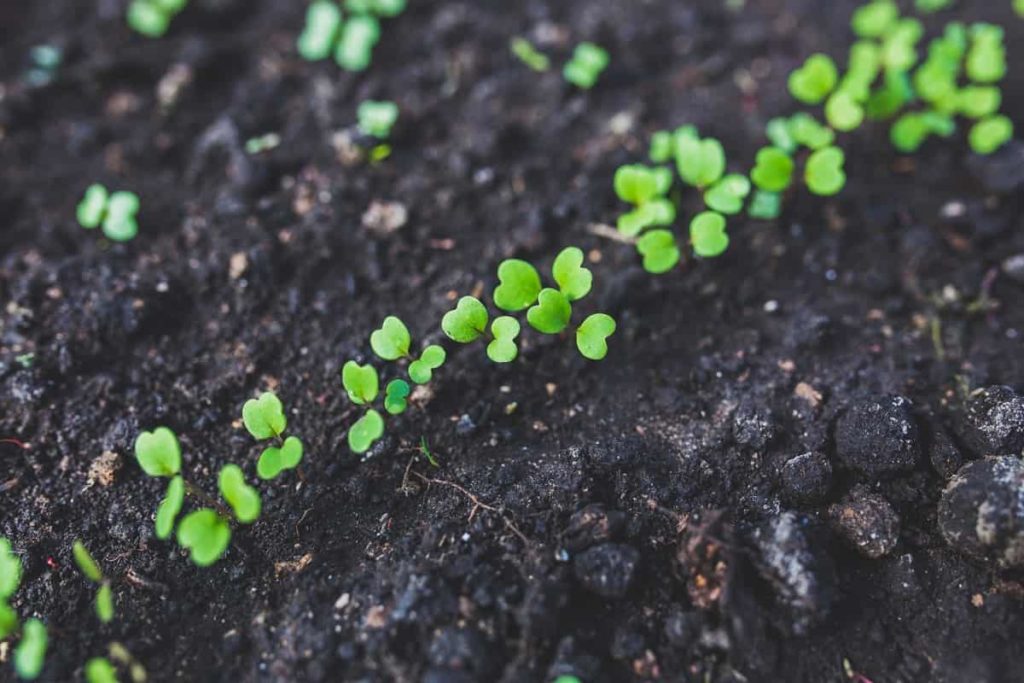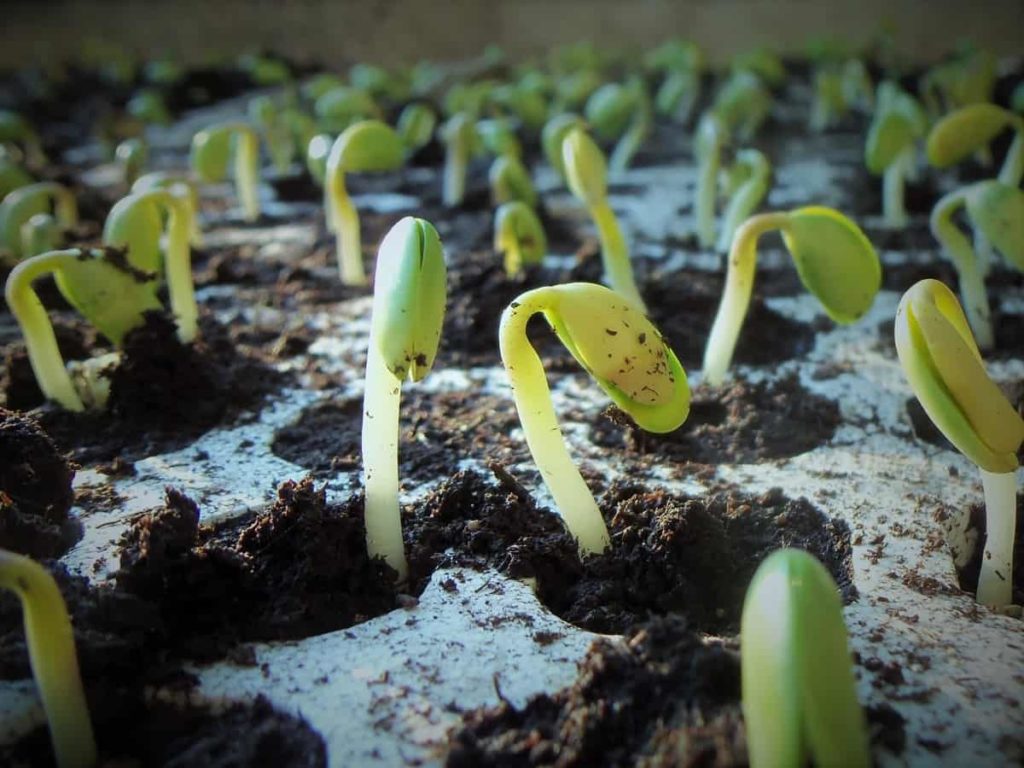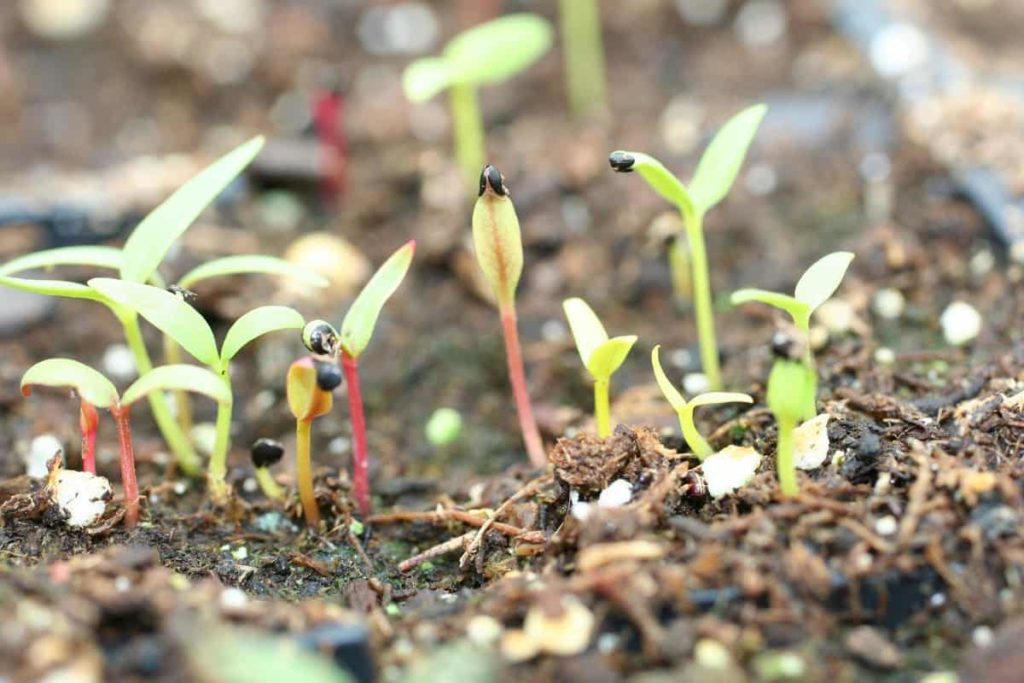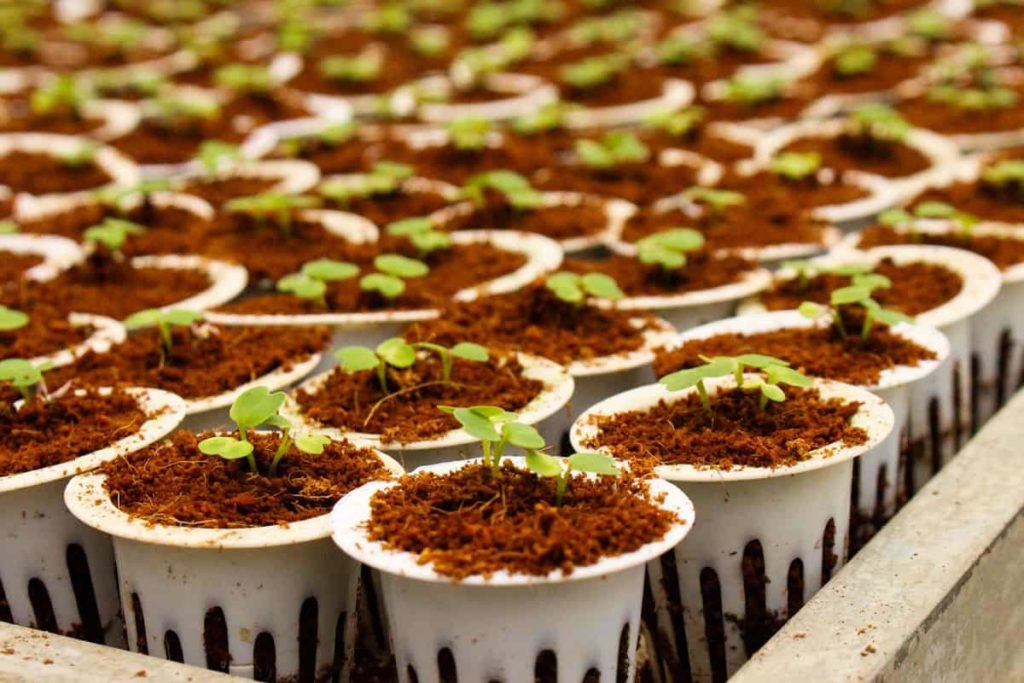Seed germination is an important process that affects crop yield and quality. Therefore, understanding the molecular aspects of seed dormancy and germination is crucial to improving crop yield and quality. Seed germination is the growth of a plant from a seed.

Seed germination ideas
What is the process of seed germination?
The seed germination process involves the following five changes or stages: imbibition, respiration, the effect of light on seed germination, mobilization of reserves during seed germination, and the role of growth regulators and embryo axis development. The complete process of seed germination is done in the following steps;
1. During the initial germination stage, seeds take up water rapidly, resulting in swelling and softening of the seed coat at higher temperatures. This stage is called imbibition. It initiates the growth process by activating enzymes. The seed activates its internal physiology and begins to respire, produce protein, and metabolize stored food. It is an intermediate stage of seed germination.
2. By rupturing the seed coat, the radicle emerges to form a primary root. The seed begins to absorb water from the ground. After the radicle and plumule emerge, the shoots begin to grow upwards.
3. In the final stage of seed germination, the seed cell becomes metabolically active, elongates, and divides to give rise to the seedling.
What are the requirements for seed germination?
Seeds generally need water, oxygen, and the right temperature to germinate successfully. Some seeds also need adequate light. Some grow best in full light, while others need darkness to grow.
1. Water: It is essential for the germination of seeds. Some seeds are extremely dry and require a substantial amount of water relative to the dry weight of the seed. Water plays an important role in seed germination. It helps to provide the hydration necessary for the vital activities of the protoplasm, provides dissolved oxygen for the growing embryo, softens the seed coats, and increases the permeability of the seed. It also helps in seed germination and converts insoluble nutrients into soluble forms for translocation to the embryo.
2. Oxygen is an essential energy source required for seed growth. It is required by the germinating seed for metabolism and is used as part of aerobic respiration until it manages to grow its green leaves. Oxygen can be found in the pores of soil particles, but if the seed is buried too deep, it will be deprived of this oxygen. Soil aeration is essential for seed germination as oxygen is essential for aerobic respiration, from which seeds obtain the energy required for embryo development.
3. Temperature: For a seed to germinate, it needs a medium temperature of around 25-30°C. Different seeds require different optimum temperatures. Some seeds require temperatures between 5 and 40°C. Seeds usually grow in a wide range of temperatures. However, fresh-harvested seeds of many plants germinate only within a narrow temperature range that widens only after ripening.
4. Light or darkness: This can act as an environmental stimulus. Many seeds do not germinate until they are exposed to sunlight.
What are the 3 methods for germinating seeds?
1. Paper towel method for seed germination
- The paper towel method is straightforward. All you need is a paper towel, water, and a square of plastic zip lock bag or cling wrap (and seeds, of course).
- Tear off a square of good-quality paper towels. Wet a paper towel and then wring it out so it’s damp but not dripping.
- Place your seeds on a paper towel and fold them. Place a folded paper towel in a zip lock bag or plastic wrap.
- Place on a sunny windowsill. Check the progress in 3-5 days.
In case you missed it: Paper Towel Seed Germination Process: for Vegetables, Fruits, Flowers, and Herbs

2. Rockwool seed germination method
- Rockwool is often used for home insulation to reduce noise and prevent mold. Go to your local nursery or hydroponics store and pick up some small Rockwool cubes, either with or without holes.
- Soak the rock wool in water for a few hours, longer if desired. Make a hole with a toothpick or knife. Insert the seed into the hole and push it down. Place the Rockwool on your windowsill and play the waiting game.
- This method works great for hydroponics systems where you can use Rockwool throughout the process. Otherwise, separating the young plant from the Rockwool may be difficult.
3. Regular seed germination method
- It is the regular method and simply involves mixing some high-quality potting mix with compost. You might think this method is hopeless, but I’ve had a lot of success following the specific needs of the seeds.
- Make sure you read the seed packet to check if the soil needs to be kept moist or if watering is only required after the seeds emerge.
- Mix 2/3 standard potting soil with 1/3 compost. Top with seeds, then cover with a light layer of soil. Gently tap the soil so the seeds don’t move around.
- Water occasionally as needed. Wait until the seedlings burst. It may take a long time. It took 2-3 weeks for the Mint plant to appear.
What are the factors that affect seed germination?
- Water
- Oxygen
- Temperature
- Light
In planting, days to germination refers to the time it takes for a seed to germinate after you plant and water it. It’s given in a range, so you know when to look for seedlings.
How do you make seeds germinate quickly?
The fastest-growing seeds include everything in the Cabbage family – Bok Choi, Broccoli, Beans, Chives, Lettuce, Kale, Cauliflower, etc.
Annual flowers – Instead of buying transplants at the garden center this year, start some annuals from seeds. Fast-sprouting varieties include Alyssum, Bachelor’s Button, Cosmos, and Marigold.
To speed up seed germination;
- Grow seeds on paper towels – Growing seeds on paper towels can sprout three times faster.
- Pre-soak your seeds for faster germination – One of gardening’s best-kept secrets is that soaking your seeds encourages faster germination.
- Use a cold treatment for some seeds – The next trick to making seeds germinate faster is to use stratification, which is when you expose seeds to periods of moist frost. It tricks the seeds into thinking they are going through the winter period. Stability imitates nature; birds drop seeds that survive the cold period throughout the winter and germinate in the spring.
- Try to scarify your seeds – A final tip for germinating seeds quickly is to use scarification, removing the seed coat with a knife or sandpaper. By doing this, moisture reaches the seed embryo, causing it to germinate faster. Treat the seeds before planting them. You don’t want to leave the scarred seeds where bacteria can enter.
Why do some seeds fail to germinate?
Too little or too much water is the cause of the seeds not germinating. With little or no water, the seeds remain dormant. With too much water, the seeds are susceptible to rotting or infection by soil-borne fungi (also known as “dampening off”). Seeds will not germinate as well in light as in darkness; light decomposes carbonic acid gas, releases oxygen, and fixes carbon; thus hardening all parts of the seed and preventing vegetation. There are many reasons for seeds failing to germinate, so let’s take each one in turn.
Old seed: Seeds have a use-by date. Check seed packets carefully and if in doubt, try a simple germination test to see if the seeds are good for sowing or throwing. Some vegetable seeds, such as Parsnips and Onions, keep for only one year, while others store well for five years or more. How you store the seed also has a profound effect on its viability. \
In case you missed it: Gardening Tips for Beginners: At Home, in Pots/Containers, Indoors, On Terrace for Vegetables, Flowers, Fruits, and Herbs

Not enough time for seed germination – The instructions on the seed package indicate how long it will take for the seed to germinate. It is only an average time based on ideal growing conditions, such as temperature, humidity, and seed starting medium. Seeds with less than ideal growing environments will require additional germination time. Give your seeds a few more days.
Too much water: As mentioned above, too much moisture can cause the seeds to rot. Make a watering schedule for the seeds until they germinate, usually once or twice a day. Once the seeds have germinated, cut back slightly when watering to avoid soggy conditions. Damping off occurs when germinated seeds flop and die from being too wet.
Why does soaking seeds help seeds germinate faster?
It is the secret to increasing germination rates and growing more plants, whether you’re short on time in the garden or forget to water as often as you like. A batch of seeds can be encouraged to grow more uniformly. However, there is little evidence that soaking improves overall germination rates for most high-quality seeds.
Soaking seeds moistens the embryo, helping it to break the shell and emerge faster. Exposure to water allows seeds to swell as water penetrates the seed coating, and the embryo begins to plump. Never soak the seeds for more than 24 hours, or it may cause them to rot. After 24 hours of soaking, plant them immediately in soil, whether in a pot or on the ground. This method works with all seeds, but it works best with larger seeds, like Beans or Squash seeds.
What are the problems in germination?
- Dry soil
- Inadequate light
- Overwatering
- Difficult seeds
- Low seed vigor
- Poor soil conditions
- Plant genetics / slow germination
- Improperly planted seeds
Why are my seeds taking so long to germinate?
- A seed usually needs water to germinate. As the seeds mature, they dry out. To germinate successfully, these mature seeds need a lot of water. Only when they absorb enough water can cellular metabolic processes and growth occur.
- The germination speed mainly depends on your room’s temperature—the warmer the environment, the faster the germination.
Do seeds germinate faster in paper towels?
Many seeds germinate much faster in paper towels (vs. seeds started in soil). The heat, humidity, and controlled conditions inside the plastic bag help them germinate in just a few days (or less, depending on the seed). The paper towel method offers a controlled environment for successful germination. The disease is not a factor because the towel is sterile. The humidity and temperature inside the towel are controlled by daily observation. The fact that you can see the root emerging helps you know when to plant the seed. There’s no telling if the seed has failed while hidden in the soil.
Does soaking seeds help in germination?
- After soaking your seeds, they can be planted as directed.
- The main benefit of soaking seeds before planting is that your germination time will be reduced, which means you can grow plants happily and quickly.
Do seeds germinate better in the dark?
Most seeds grow best when kept in the dark. The presence of light, which is critical for seed development, can inhibit the germination process.
How do you grow seeds with a paper towel and zip lock bags?
Dampen a paper towel and then put it in the bag. Place the seeds on one side of the bag, pressing them down with a paper towel. Close the bag tightly and hang it in the window using tape. Growing seeds in a paper towel is a soil-less way to get your plants started quickly. The secret to successful seed germination is using a bag for the most efficient germination. It saves time, gives better results, and is less expensive.
Below are some tips to make the whole experience more fun and productive:
- Use a marker to write the name of the seed and date on the ziplock bag before putting it in a paper towel. It’s a great idea to label your bags, so you don’t get confused about the identity of the seeds and lose count of the days.
- Plant stubborn seeds like Pepper first because they are hard to grow in the ground. This method can be very effective in stimulating germination.
- Record your progress using a gardening journal. It is fun because you can get creative and make tables and timelines. You can also do it digitally.
- Don’t pack all your seeds in a zip lock at once for germination. Space your seed germination, so you have something to look forward to, and plant times vary. If you plant all the tomatoes on the same day, most of them will be ready to harvest simultaneously. But if you plant them for 15 days, you will have a constant fresh supply.
What are the advantages of paper towel seed germination?
Good things about starting seeds in wet paper towels. Some of the best benefits of germinating seeds in plastic bags with a damp paper towel are:
- Fast Germination – Seeds can germinate overnight or in just a few days. (Some seed varieties take longer, but the overall process is faster)
- Less Mess – Starting seeds in plastic bags with wet paper towels means a little potting soil initially—no need to mess around. Enjoy cleaning your garden and a quick start.
- Seed Viability Testing – The paper towel seed germination method makes testing your seeds’ germination rate and viability easy. It is useful when you have limited gardening space.
- Saves Space – Starting seeds in the soil can take a lot of space, especially since you’ll need more starting to prepare seeds that don’t germinate. By pre-sprouting seeds, you only need containers for seeds that have germinated.
- Small Space Friendly – Even if your indoor gardening setup is limited, you can still enjoy starting countless seeds.
In case you missed it: Paddy Seed Germination, Process, and Methods

How much time do seeds germinate in a paper towel take?
- They take ten days to germinate. To grow seeds in paper towels, collect the seeds, paper towels, and silicone or plastic bags.
- Label the bag using tape (if silicone bags) and a permanent marker with the date and name of the plant.
- The germination rate of vegetable seeds varies widely depending on soil and air temperature.
- Germination is accelerated by keeping the seeds at optimum temperature. Cold temperatures reduce the rate of germination.
How do you make vegetable seeds germinate faster?
An easy method to get seeds to germinate faster is to soak them in a shallow container filled with warm tap water for 24 hours. Do not soak seeds for more than 24 hours as they may rot. Plant the seeds immediately in moist soil.
| Vegetable | Days for germination |
| Asparagus | 14-18 days |
| Beans | 4-10 Days |
| Beets | 4-10 Days |
| Brussels Sprouts | 3-10 Days |
| Broccoli | 7-10 Days |
| Cabbage | 5-10 Days |
| Carrots | 6 Days |
| Cauliflower | 4-10 Days |
| Celery | 10 Days |
| Collard Greens | 5-10 Days |
| Cucumber | 5-7 Days |
| Eggplant | 10-15 Days |
| Garlic | 7-14 Days |
| Kale | 5-7 Days |
| Lettuce | 2-10 Days |
| Okra | 7-12 Days |
| Peas | 5-7 Days |
| Pepper | 7-10 Days |
| Radishes | 4-10 Days |
| Spinach | 6-14 Days |
| Tomatoes | 5-7 Days |
Why won’t my seeds germinate in paper towels?
Paper towel too wet – Seeds that float in water can rot before germinating, especially if they require a long germination period. Paper towel is too dry: Seeds need constant moisture to germinate, and you may need to wash the paper towel periodically to keep it moist.
Does temperature affect seed germination?
- Temperature affects germination in three primary ways: humidity, hormone production, and enzyme activity.
- For seeds to grow, they need water. To do this, there must be enough moisture.
- A hot climate can increase evaporation and decrease humidity, adversely affecting germination.
How do you tell if a seed is germinated?
- Take your seeds if it is germinated and put them in a pot of water. Let them sit for about 15 minutes.
- If the seeds sink, they are still viable. If they float, they most likely won’t germinate.
Can seeds be too wet to germinate?
Planting in the wrong soil: Seeds need constant moisture to germinate, but the soil should never be soggy or wet.
Therefore, use a quick-release seed-starting mix that allows water to pass through quickly.
In case you missed it: Brinjal Seed Germination (Eggplant) Procedure

What is a seed germination test?
- A germination test finds the percentage of seeds that survive in any seed lot.
- Germination level combined with seed vigor provides a good estimate of potential field performance.
- While germination speed varies slightly among varieties, the seeds should absorb moisture within two days and produce a root and first leaf within four days.
- At this point, the seed has to be germinated.
Do seeds need light to germinate?
- Some seeds do not need light to break their seed coat and germinate. Most seeds grow best with controlled amounts of UV generation, but some grow without light.
- Additionally, some plants get plenty of light, even in the darkest or shady areas of the garden. Although most seeds need to be covered to block light before they germinate, some seeds require light to germinate.
- Both annual bedding plants germinate Begonias, and Impatiens need light to grow. Lettuce and Dill also need light to germinate.
- These seeds need to be spread on top of the soil and placed in an area that receives bright light for germination. If the seeds are kept in the dark, they may not germinate.
- Check the seed packet carefully for instructions on whether your seeds need light to germinate.
How much water do seeds need to germinate?
- Keep the seed bed moist, never letting it dry out, about once a day until the seeds emerge. Water with a fine spray hose nozzle or watering can that will provide a fine misting spray and not wash away the soil.
- Water is often enough (usually once a day) so that the soil surface never dries out but is constantly moist.
What is the best soil for seed germination?
The best seed starting mix is perlite, vermiculite, and sphagnum peat moss.
How many hours of light are required for seed germination?
- Most seeds will not germinate without sunlight and will do best with 12 to 16 hours per day.
- Indoors, place the seed containers in a sunny, south-facing window and turn the container a quarter-turn each day to prevent the plants from moving toward the light and developing weak, elongated stems.
Do seeds germinate faster in warmer temperatures?
- Energy is required for seed germination. The closer the temperature is to the optimum temperature, the faster the germination.
- Warmth is required to speed up the chemical reactions in seeds.
- The warmth also stimulates the production of new cells when the embryo is most important for germination.
In case you missed it: Tomato Seed Germination, Time Period, and Procedure

Conclusion
Seed germination can be defined as the basic process by which different plant species grow from a seed into a plant. This process affects both the yield and quality of the crop. When the right factors are present, the seeds begin to germinate. The above information helps to know how to germinate seeds and fix the most common seed germination problems.
- How to Build a Low-budget Goat Shed: Cheap Ideas and Tips
- Goat Farming Training Programs in India: A Beginner’s Guide
- Types of Pesticides Used in Agriculture: A Beginner’s Guide
- Economical Aquaculture: A Guide to Low-Budget Fish Farming
- 15 Common Planting Errors That Can Doom Your Fruit Trees
- How to Make Houseplants Bushy: Effective Tips and Ideas
- Innovative Strategies for Boosting Coconut Pollination and Yield
- Pollination Strategies for Maximum Pumpkin Yield
- The Complete Guide to Chicken Fattening: Strategies for Maximum Growth
- Natural Solutions for Tulip Problems: 100% Effective Remedies for Leaf and Bulb-Related Issues
- Revolutionizing Citrus Preservation: Towards a Healthier, Greener Future
- Natural Solutions for Peony Leaf and Flower Problems: 100% Effective Remedies
- Maximizing Profits with Avocado Contract Farming in India: A Comprehensive Guide
- Natural Solutions for Hydrangea Problems: 100% Effective Remedies for Leaf and Flowers
- The Ultimate Guide to Choosing the Perfect Foliage Friend: Bringing Life Indoors
- From Sunlight to Sustainability: 15 Ways to Use Solar Technology in Agriculture
- The Ultimate Guide to Dong Tao Chicken: Exploring from History to Raising
- The Eco-Friendly Makeover: How to Convert Your Unused Swimming Pool into a Fish Pond
- Mastering the Art of Delaware Chicken Farming: Essentials for Healthy Backyard Flocks
- 20 Best Homemade Fertilizers for Money Plant: DIY Recipes and Application Methods
- How to Craft a Comprehensive Free-Range Chicken Farming Business Plan
- Brighten Your Flock: Raising Easter Egger Chickens for Beauty and Bounty
- How to Optimize Your Poultry Egg Farm Business Plan with These Strategies
- Subsidy for Spirulina Cultivation: How Indian Government Schemes Encouraging Spirulina Farmers
- Ultimate Guide to Raising Dominique Chickens: Breeding, Feeding, Egg-Production, and Care
- Mastering the Art of Raising Jersey Giant Chickens: Care, Feeding, and More
- Ultimate Guide to Raising Legbar Chickens: Breeding, Farming Practices, Diet, Egg-Production
- How to Raise Welsummer Chickens: A Comprehensive Guide for Beginners
- How to Protect Indoor Plants in Winter: A Comprehensive Guide
- Ultimate Guide to Grow Bag Gardening: Tips, Tricks, and Planting Ideas for Urban Gardeners
- Guide to Lotus Cultivation: How to Propagate, Plant, Grow, Care, Cost, and Profit
- Agriculture Drone Subsidy Scheme: Government Kisan Subsidy, License, and How to Apply Online
- Ultimate Guide to Raising Araucana Chickens: Breed Profile, Farming Economics, Diet, and Care
- Bringing Hydroponics to Classroom: Importance, Benefits of Learning for School Students
- Ultimate Guide to Raising Polish Chickens: Breed Profile, Farming Economics, Diet, and Care
- Ultimate Guide to Raising Australorp Chickens: Profile, Farming Economics, Egg Production, Diet, and Care